Differences in serum and synovial CD4+ T cells and cytokine profiles to stratify patients with inflammatory osteoarthritis and rheumatoid arthritis
- PMID: 28526072
- PMCID: PMC5437517
- DOI: 10.1186/s13075-017-1305-1
Differences in serum and synovial CD4+ T cells and cytokine profiles to stratify patients with inflammatory osteoarthritis and rheumatoid arthritis
Abstract
Background: The aim was to investigate CD4+T-cell subsets, immune cells and their cytokine profiles in blood and synovial compartments in rheumatoid arthritis (RA) and inflammatory osteoarthritis (OA) to define specific immune signatures.
Methods: Peripheral blood, synovial fluid (SF) and synovial membranes (SM) of RA and OA patients were analyzed. CD4+T-cell subset frequencies were determined by flow cytometry, and cytokine concentrations in serum and SF were measured by ELISA.
Results: In peripheral blood, OA patients had altered frequencies of regulatory T-cell subsets, and higher frequencies of Th17 and of Th1/17 cells than RA patients. In the synovial compartment of OA patients, conventional Th17 cells were largely excluded, while Th1/17 cells were enriched and more frequent than in RA patients. Conversely, in the synovial compartment of RA patients, regulatory T cells and Tfh cells were enriched and more frequent then in OA patients. IL-17 and Blys were increased both in serum and SF of RA patients, and correlated with autoantibodies and disease activity. Notably, Blys levels were already significantly elevated in RA patients with low disease activity score in 28 joints (DAS28) and without autoantibody positivity.
Conclusions: Although patients with inflammatory OA have immune activation in the synovial compartment, they display different T-cell subset frequencies and cytokine profiles. Soluble mediators such as Blys might help to discriminate mild clinical forms of RA from inflammatory OA particularly at the onset of the disease.
Keywords: Blys; Cytokines; Inflammatory osteoarthritis; Rheumatoid arthritis; T helper subsets.
Figures
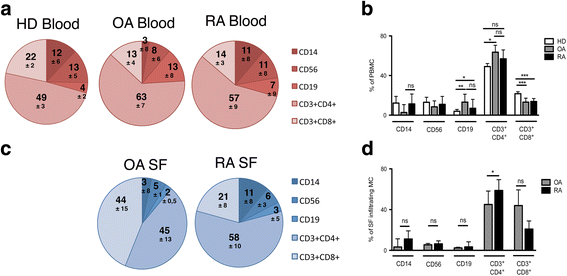
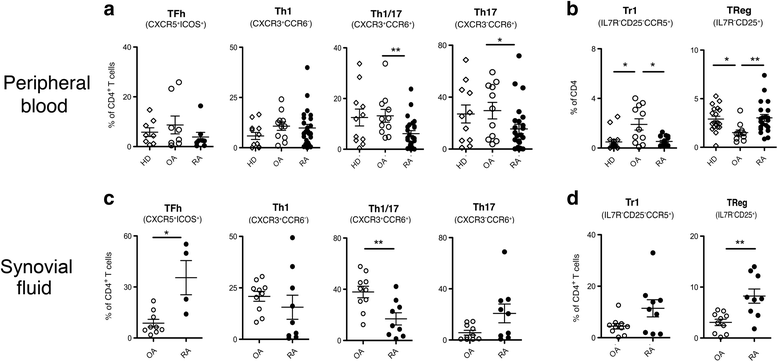
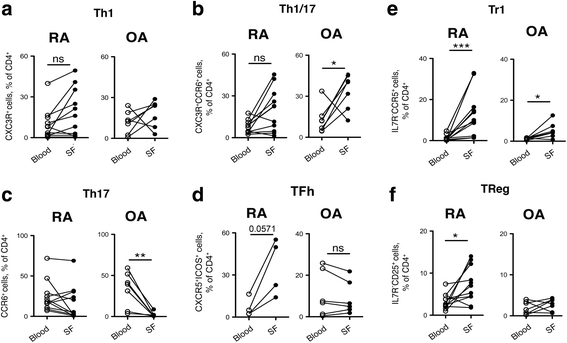
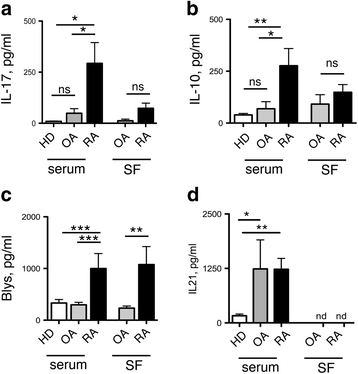
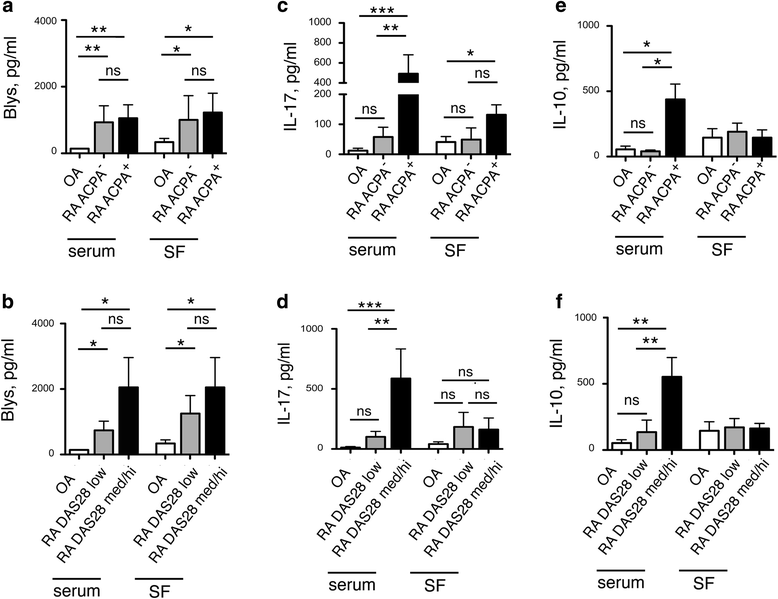
Similar articles
-
CD4⁺CD25⁺/highCD127low/⁻ regulatory T cells are enriched in rheumatoid arthritis and osteoarthritis joints--analysis of frequency and phenotype in synovial membrane, synovial fluid and peripheral blood.Arthritis Res Ther. 2014 Apr 17;16(2):R97. doi: 10.1186/ar4545. Arthritis Res Ther. 2014. PMID: 24742142 Free PMC article.
-
Preferential accumulation of activated Th1 cells not only in rheumatoid arthritis but also in osteoarthritis joints.J Rheumatol. 2011 Aug;38(8):1569-75. doi: 10.3899/jrheum.101355. Epub 2011 May 1. J Rheumatol. 2011. PMID: 21532055
-
Different distribution of CD4 and CD8 T cells in synovial membrane and peripheral blood of rheumatoid arthritis and osteoarthritis patients.Folia Histochem Cytobiol. 2009;47(4):627-32. doi: 10.2478/v10042-009-0117-9. Folia Histochem Cytobiol. 2009. PMID: 20430731
-
Effector Functions of CD4+ T Cells at the Site of Local Autoimmune Inflammation-Lessons From Rheumatoid Arthritis.Front Immunol. 2019 Mar 12;10:353. doi: 10.3389/fimmu.2019.00353. eCollection 2019. Front Immunol. 2019. PMID: 30915067 Free PMC article. Review.
-
Mechanisms of immune injury in rheumatoid arthritis: evidence for the involvement of T cells and heat-shock protein.Immunol Rev. 1990 Dec;118:233-55. doi: 10.1111/j.1600-065x.1990.tb00818.x. Immunol Rev. 1990. PMID: 1967122 Review.
Cited by
-
Low-dose IL-2 therapy limits the reduction in absolute numbers of circulating regulatory T cells in rheumatoid arthritis.Ther Adv Musculoskelet Dis. 2021 Apr 28;13:1759720X211011370. doi: 10.1177/1759720X211011370. eCollection 2021. Ther Adv Musculoskelet Dis. 2021. PMID: 33995604 Free PMC article.
-
Kartogenin inhibits pain behavior, chondrocyte inflammation, and attenuates osteoarthritis progression in mice through induction of IL-10.Sci Rep. 2018 Sep 14;8(1):13832. doi: 10.1038/s41598-018-32206-7. Sci Rep. 2018. PMID: 30218055 Free PMC article.
-
Osteoimmunology of Oral and Maxillofacial Diseases: Translational Applications Based on Biological Mechanisms.Front Immunol. 2019 Jul 18;10:1664. doi: 10.3389/fimmu.2019.01664. eCollection 2019. Front Immunol. 2019. PMID: 31379856 Free PMC article. Review.
-
Soluble epoxide hydrolase inhibitor blockage microglial cell activation in subnucleus caudalis in a persistent model of arthritis.Int Immunopharmacol. 2023 Jul;120:110320. doi: 10.1016/j.intimp.2023.110320. Epub 2023 May 23. Int Immunopharmacol. 2023. PMID: 37230034 Free PMC article.
-
Tripterygium Ingredients for Pathogenicity Cells in Rheumatoid Arthritis.Front Pharmacol. 2020 Oct 2;11:583171. doi: 10.3389/fphar.2020.583171. eCollection 2020. Front Pharmacol. 2020. PMID: 33123015 Free PMC article. Review.
References
Publication types
MeSH terms
Substances
LinkOut - more resources
Full Text Sources
Other Literature Sources
Medical
Research Materials

